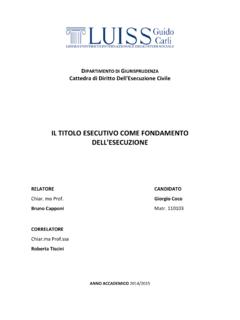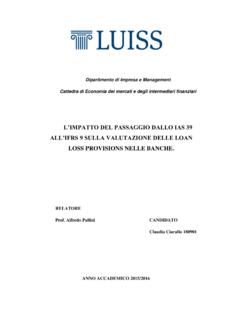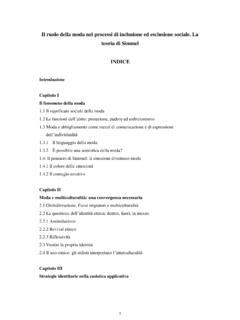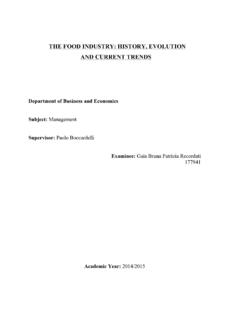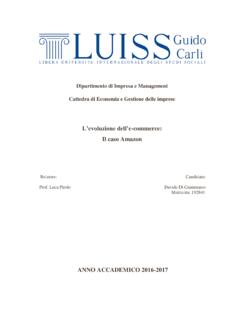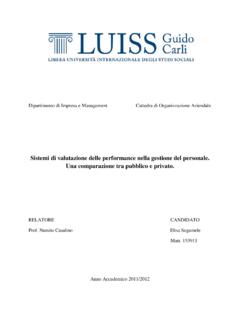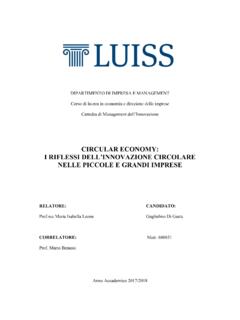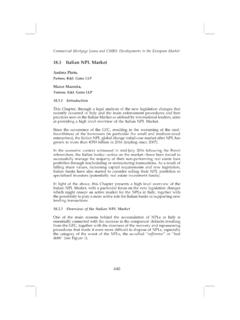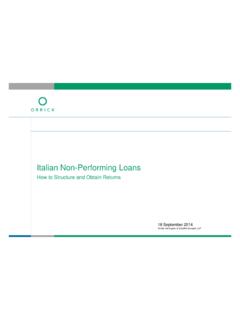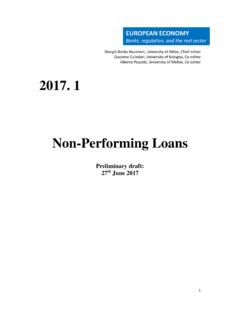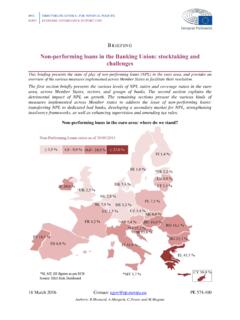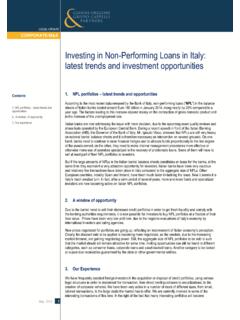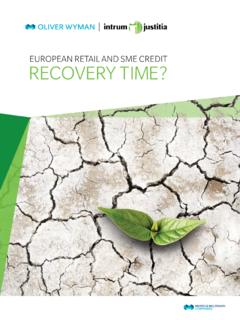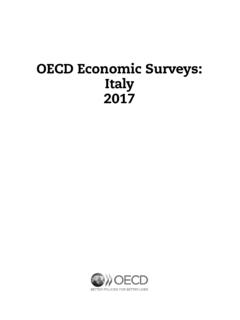Transcription of A secondary market for NPLs: The Italian government’s ...
1 DEPARTMENT OF BUSINESS AND MANAGEMENT Master Thesis in Advanced Corporate Finance A secondary market for NPLs: The Italian government s response and potential consequences for the listed banks SUPERVISOR Prof. Raffaele Oriani CANDIDATE Caterina Crociata 666601 CO SUPERVISOR Prof. Alessandro Pansa Academic Year 2015-2016 1 2 Acknowledgment Firstly, I would like to express my gratitude towards my parents and my sister for their fundamental role during all my academic path. They have always been by my side, supporting me and pushing me towards my dreams. Secondly, I would like to thank my academic supervisor Raffaele Oriani for giving me unconditional support during the whole thesis preparation. His constant guidance and advice have been a precious help for the completion of this dissertation. My thanks also go to Alessandro, Giovanni, Saverio, Chen and the whole team of Lazard Milan. 3 4 Table of Contents ACKNOWLEDGMENT.
2 2 INTRODUCTION .. 8 CHAPTER 1: OVERVIEW OF NON-PERFORMING LOANS .. 10 DEFINITION AND CLASSIFICATION .. 10 DETERMINANTS OF NON-PERFORMING LOANS .. 14 IMPACT OF NPLS ON BANKS PERFORMANCE .. 18 IMPACT OF NPLS ON THE REAL ECONOMY .. 21 MANAGEMENT OF NON-PERFORMING LOANS .. 22 Internal Management .. 24 Servicing Transfers .. 25 Joint Venture .. 25 Direct Sales .. 26 Bad Bank .. 27 CHAPTER 2: VALUATION OF NON-PERFORMING LOANS .. 30 IAS 39: THE AMORTIZED COST APPROACH .. 30 THE BASEL FRAMEWORK .. 33 FROM IAS 39 TO IFRS 9 .. 35 THE FAIR VALUE APPROACH .. 38 CHAPTER 3: THE Italian NPL market .. 39 OVERVIEW OF THE Italian BANKING SYSTEM .. 39 A market FOR NPLS IN ITALY .. 46 Main Impediments .. 48 Potential Benefits .. 51 THE PROBLEM: A WIDE BID-ASK SPREAD .. 51 Banks vs. Investors Valuation Perspective .. 54 CRITICAL ISSUES IN REDUCING THE GAP .. 57 Aligning the Book Value to the market Price .. 57 The impossibility of an Italian Bad Bank.
3 58 5 CHAPTER 4: GOVERNMENT STRATEGIES AND POTENTIAL IMPACTS .. 60 A THREE-PRONGED STRATEGY .. 60 Structural Measures .. 61 The GACS (Garanzia Cartolarizzazione Sofferenze) .. 65 The Atlante Fund .. 68 POTENTIAL CONSEQUENCES FOR THE LISTED BANKS .. 71 Panel Selection .. 71 Assumptions and Potential Scenarios .. 74 Discussion of Results .. 89 CONCLUSION .. 93 REFERENCES .. 95 6 Table of Figures and Tables Figure : Umbrella approach for the definitions of forbearance and non-performing .. 11 Figure : Current Italian loans classification .. 14 Figure : Rise in NPL ratios vs. real GDP growth in 2009 .. 15 Table : Summary of NPL determinants and related studies .. 17 Figure : Implications of High NPLs for Bank Performance in the Euro Area .. 20 Figure : JV Arrangement Option .. 26 Figure : Outright Cash Sale Option .. 26 Figure : IFRS 9 The three stage model .. 36 Table : Financial Intermediation Ratio.
4 39 Table : Banking Intermediation Ratio .. 40 Table : Bank lending breakdown .. 41 Table : Italian bank categories .. 42 Table : Structural Financial Indicators .. 42 Figure : Gross NPEs and NPLs trend .. 43 Figure : Gross NPLs breakdown .. 44 Figure : New vs. extinguished NPLs .. 45 Figure : Extinguished NPLs as a % of Gross NPLs .. 45 Figure : NPEs transactions in the Italian market .. 46 Figure : NPEs transactions in Europe .. 47 Figure : Price gap between supply and demand for NPLs .. 52 Figure : Average length of foreclosure procedures by country .. 53 Figure : Banks vs. Investors valuation perspective .. 56 Table : Impact of a haircut on NPL s net value .. 58 Figure : Bankruptcies closed per month .. 64 Figure : NPL securitization under the GACS scheme .. 65 7 Figure : market reaction to the launch of Atlante fund .. 69 Figure : Aggregated NPEs breakdown .. 72 Figure : Aggregated bad loans ratios .. 72 Figure : Net NPEs and NPLs by banks.
5 73 Figure : Texas ratio by banks .. 73 Figure : Incremental path of NPLs transfer price Scenario 3 .. 82 Figure : Incremental path of NPLs transfer price Scenario 4 .. 84 Figure : Incremental path of NPLs transfer price Scenario 5 .. 87 Figure : Aggregated Texas ratio potential evolution .. 91 Figure : Aggregated Net NPLs ratio potential evolution .. 91 Figure : Capital shortfall/buffer by bank vs. market cap correction .. 94 8 Introduction Nowadays non-performing loans (NPLs) are among the hottest financial topics and definitely one of the top priorities of European politicians and supervisory authorities. The global financial crisis and the subsequent recession have caused a sharp deterioration in banks credit quality, which is then translated into a restriction in the supply of credit and/or a worsening of lending conditions, subsequently affecting the growth prospects of viable firms.
6 However, while in some countries, like the United Kingdom, Ireland and Spain, the problem has been promptly managed with the creation of systemic bad banks, in Italy the stock of NPLs has more than quadrupled since 2008, to reach the historical peak of 341 billion (of which 200 billion of bad loans) in December 2015. At the same time, sales transactions of NPLs have been of limited amount due to the lack of a secondary market , whose development has been hampered by many factors, such as the length and inefficiency of foreclosure and insolvency procedures, the information asymmetry between originating banks and investors and the still uncertain prospects of economic recovery. Only recently, the Italian government has adopted various structural measures to overcome what is the real underlying problem: the price gap between seller banks and buyer investors, a disagreement amounting today to around 20%.
7 However, given the continuing speculation on Italian banks, it would seem that investors believe that a definitive solution to the problem of NPLs has not yet been found. In short, the purpose of this work is to analyze and discuss the problem of NPLs in Italy, the Italian Government s response and the possible impacts on profit and capital adequacy that the sale of NPLs would have on the major Italian listed banks. The thesis is organized in four chapters. Chapter 1 initially describes Non-Performing Loans and the recent classification provided by the European Banking Authority (EBA). A special section is then dedicated to the literature review on NPLs determinants, namely those macroeconomic and bank-specific factors explaining the behavior of NPLs. Once described the causes of asset quality deterioration, it is presented a deeper analysis on the NPLs implications on banks performance ( profitability, capital adequacy, asset quality, liquidity, and efficiency) and the feedback effects between the real and financial sectors.
8 The final part of the chapter describes the management of NPLs and, especially, the potential strategies (and their pros and cons) that banks can adopt to address the problem of NPLs, according to a different degree of outsourcing. 9 Chapter 2 offers an overview of NPLs valuation. More specifically, it describes in detail the provisions of IAS 39 (which all Italian banks should follow, like the main European banks that adopt the IAS-IFRS accounting principles) on loans recognition and measurement, the divergences with the Basel framework and the attempt to align regulatory and accounting requirements with the new IFRS 9. Then is presented an alternative valuation method to the amortized cost, namely the fair value approach, which most closely matches the perspective of investors. Chapter 3 describes the current situation with NPLs in Italy. Following the overview of Italian banking system and the comparison with the other three large euro zone economies (Germany, France and Spain), this chapter introduces the current problem of a poorly developed secondary market for NPLs and the main impediments, both on the supply and on the demand side, which have left Italy behind other EU countries.
9 At the same time, it has been described the potential benefits of having an active and liquid market for distressed loans. The final part of the chapter looks into the true problem (and its determinants) with the inefficiency of the NPLs market in Italy, namely the wide gap between the price at which banks would be willing to sell their NPLs and the price at which investors are willing to buy. Hence, two critical issues in reducing the gap are discussed: aligning the book value of non-performing loans to the current market prices and the impossibility of an Italian systemic bad bank. Finally, in Chapter 4 it is presented the Italian Government strategy for fostering a market for NPLs and the potential impacts of NPLs disposals on a sample of Italian listed banks. More specifically, the first part of the chapter discusses the three main strands of the strategy (and their pros and cons): (i) a package of structural measures on both legal and fiscal aspects, (ii) the GACS, a State guarantee scheme to facilitate the NPL securitization and (iii) Atlante , a private fund whose purpose is to act as a buyer of last resort for those banks that face market difficulties.
10 The second part is instead an attempt to evaluate the possible implications of the measures so far adopted, and more generally, the potential impacts of NPLs disposals on banks net profit and capital. In doing so, it has been first selected a sample of eleven Italian listed banks; then two kind of simulations have been conducted: a NPL coverage uplift and a potential NPLs deconsolidation, at different selling prices and percentages of gross NPLs to be sold. Hence, aggregated and individual results are discussed, highlighting those banks that are in the most trouble and that would need to raise capital in the short term. 10 CHAPTER 1 OVERVIEW OF NON-PERFORMING LOANS DEFINITION AND CLASSIFICATION The global financial crisis and the subsequent recession have revealed the recognized fragmentation of the banking systems, as well as the lack of a common scheme to classify loans, the main and most sizable asset category on banks balance sheets.

